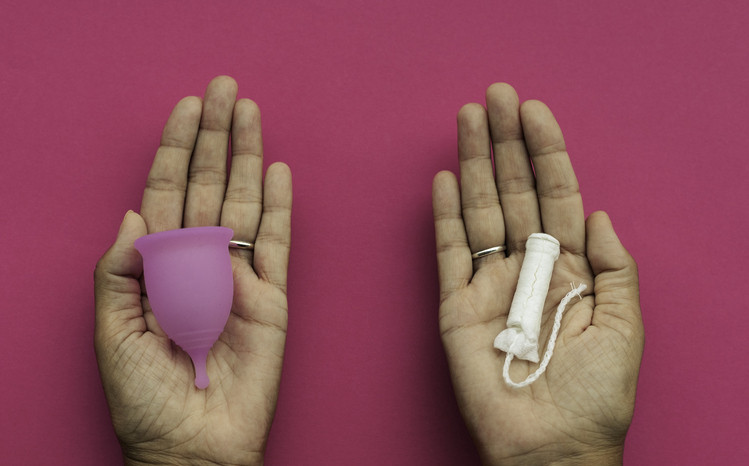How to choose period products
Cost, safety, comfort, and environmental impact can help guide personal choices.

On any given day, over 300 million people around the world are having their period. Yet the high costs of period products continue to be a problem for many. Those costs are not just financial (though period equity is a serious problem that is largely unaddressed in the US); there are also environmental, health, and safety costs to consider.
While single-use disposable period products like pads and tampons make up the majority of the multibillion-dollar global market, reusable products like cups (inserted into the vagina to collect the blood) and period panties (absorbent underwear) are beginning to gain more traction. Recently, my team took an eye-opening look at product data with respect to cost, health and safety, comfort and satisfaction, and environmental impacts in the United States.
How much do period products cost?
Scotland is the first country to offer free period products to all who need them. In the US, the upfront cost is cheapest for pads, followed by tampons — though the prices for these products increased by almost 10% in the last year. Reusable period cups and period panties are more expensive to start. Cups begin to offer cost savings by around a year.
Some factors to consider with reusables:
- You might need to try more than one period cup to find your fit, or may want to have more than one on hand. Savings go up the longer your period cup lasts, which may be from two to 10 years with good care.
- Period panties have varying absorbency, so you might choose to mix and match products depending on period flow. For example, you might use period panties on light days, or in combination with tampons or cups on heavier days. Also, they might be helpful for other reasons, like discharge or mild urinary incontinence.
Your mileage may vary, as they say, but see the chart below for a rough cost comparison of period products.
|
Product |
Cost per year |
Cost per item |
Cost over four years |
|
Disposable pads |
$40 (assuming people use 20 pads per cycle) |
|
$160 |
|
Disposable tampons |
$60 (assuming people use 20 tampons per cycle) |
|
$240 |
|
Reusable period cup |
|
$20 to $40 per cup, adding up to $60 to $120 (assuming people buy three cups to rotate) |
$60 to $120 (more if a cup doesn't last the full four years) |
|
Reusable period panty |
|
$10 to $35 per panty |
Not clear, because number of panties needed and how long they last depend on how you choose to use them. |
Health and safety of period products
Long-term exposure to high levels of toxic contaminants called dioxins can cause cancers and other health problems. Dioxins can form when bleach is used on pulp and paper products that go into pads and tampons. Most people are not exposed to high enough levels to cause health harms.
Over the years, manufacturers have modified the bleaching process to minimize dioxins in these products. Dioxin levels in tampons are much lower than FDA limits, and even lower than from exposure through food. Period cups do not contain dioxins, as they are usually made of medical grade silicone; neither do period panties (but do check that these are free of chemicals known as PFAS).
The other risk of some period products is toxic shock syndrome (TSS), a life-threatening illness related to a toxin made by certain bacteria. TSS occurs in roughly 1 in 100,000 menstruating people in the US. Reports of TSS with period cup use are even more rare. It is mostly linked with high-absorbency tampon use.
Due to changes in how tampons are made, instances of TSS have declined. Reduce your risk of TSS by not leaving in tampons for longer than eight hours or period cups for longer than 12 hours. Depending on your flow, you may need to change sooner to avoid leakage.
Comfort and satisfaction with period products
Most people are able to use tampons or cups regardless of virginity. Some people do not want to insert anything in the vagina, in which case pads or period panties would be preferred. There are plenty of choices now for period panties varying in color, cut, absorbency, and ranging in style from thong to athletic shorts. They can be purchased online or at many department stores.
Period cups might take some getting used to. A small, randomized study found that overall satisfaction was lower after the first month of cup use as compared to tampon use, but then comparatively higher after months two and three.
Environmental impacts of period products
The environmental impact of a product can be estimated through a life cycle assessment. This considers its footprint from natural resource use to greenhouse gas emissions — the major contributor to global warming and climate change. The environmental impact of disposable pads and tampons is much higher than that of reusable menstrual cups due to raw materials, manufacturing processes, and landfill waste.
Ultimately, which period products you choose may depend on several factors, and on what makes the most sense for you. The Center for Young Women's Health offers more information on disposable tampons and pads, and eco-friendly options.
About the Author

Wynne Armand, MD, Contributor
Disclaimer:
As a service to our readers, Harvard Health Publishing provides access to our library of archived content. Please note the date of last review or update on all articles.
No content on this site, regardless of date, should ever be used as a substitute for direct medical advice from your doctor or other qualified clinician.















